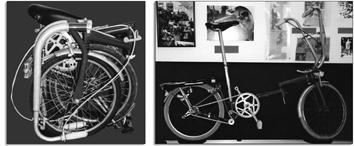6 Design and innovation 3: the Brompton folding bicycle
6.4 The second prototype (P2)
The major design difference between P1 and subsequent prototypes was the removal of the complex skewed hinge required to move the front wheel in its own plane underneath the bicycle to sit alongside the rear wheel. The front wheel now hinged orthogonal to the plane of the bicycle (i.e. it moved sideways from the line of the frame, as happens in the production model in Figure 46 (e) and (f)) using a purpose-designed hinge made from tubing.
The rear wheel continued to be folded underneath the frame, as in the production model in Figure 46. The P2 saw the introduction of castors on the rear luggage rack, on which the bicycle sat when the rear wheel was folded underneath. These too have survived, and can be seen in Figure 46.
Unlike the production model, P2's handlebars hinged down, one each side of the package. Also unlike the production model, the seat pillar of P2 consisted of more than one tube which telescoped during folding.
Two more prototypes were built using sliding tubes to produce hinges, this time with 16-inch wheels. Wheel size is a key issue for the designer of a folding bike. Smaller wheels are easier to pack small, but the smaller the wheel the bigger the pothole feels! There is also the ‘make or buy’ decision to consider. Mass production of bicycle wheels is a big issue; it is much easier for a manufacturer to buy-in wheels produced by a large manufacturer than to dedicate machinery and labour to the production of wheels just for their own product.
Andrew Ritchie's intention was to sell the design. To further this ambition, he applied for and obtained a patent in 1981. You will read more about patents in the next unit, but for now it is worth noting that his patent may have been difficult to defend, owing to the number of previous designs of folding bicycle that were available. He certainly could not have afforded to defend it if his design had been copied by a large manufacturer, but nonetheless it is a formal statement of the design, a design representation, and a claim to intellectual property.
In total Ritchie built four prototype machines, with a low main tube, between 1975 and 1979, to prove and develop his ideas. His next problem was to turn the design into a product that you or I could buy.
Before pursuing the story I shall look in some detail at the structural design of the bicycle.

